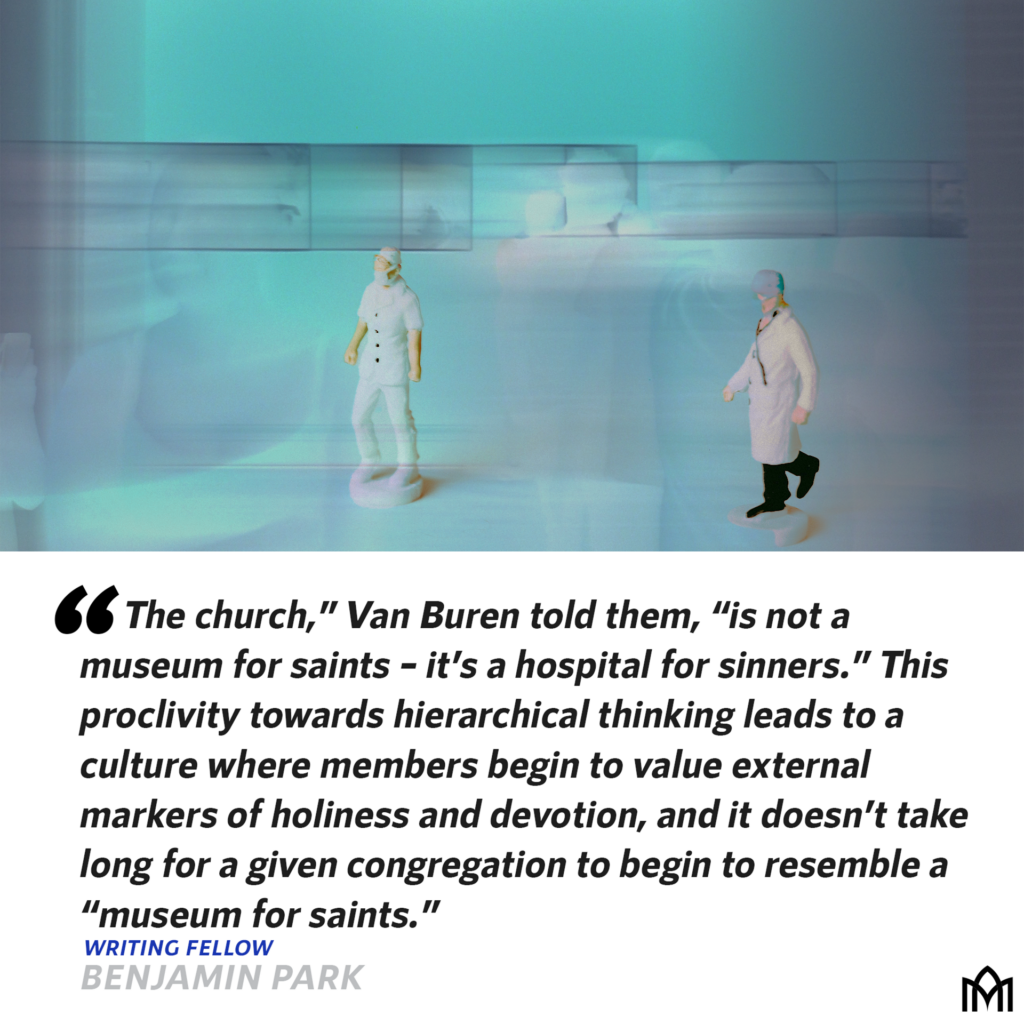More Than A Museum For Saints
In a 1964 column, the famous advice columnist Abigail Van Buren offered an encouraging word to a young, unmarried couple worried whether their new church would accept them. “The church,” Van Buren told them, “is not a museum for saints – it’s a hospital for sinners.”1Van Buren, A. (1964, March 29) Dear Abby: Sinners and Saints. Park City Daily News. Some argue that Van Buren was quoting Augustine here, but it is also possible that she simply took Jesus’ words in Mark 2:17 about the healthy not needing doctors and extrapolated what that meant for the church.
Whatever the origin, this phrase took root and resonated within Christian circles, and for good reason: with just a handful of words it pushed back against a pervasive and dangerous tendency within congregations. Although even a cursory reading of Jesus’ teachings clearly rejects any sort of posturing or concern with religious appearances, the fact is humans tend to self-rank within groups, religious or otherwise.2Gobel, M.S., & Miyamoto, Y. (2024). Self- and Other-Orientation in High Rank: A Cultural Psychological Approach to Social Hierarchy. Personality and Social Psychology Review, 28(1). Within churches, this proclivity towards hierarchical thinking leads to a culture where members begin to value external markers of holiness and devotion, and it doesn’t take long for a given congregation to begin to resemble a “museum for saints.” Thus Van Buren’s phrase has provided helpful correction.
Unfortunately, as anyone who has been around the church can attest, our problems run far deeper than the presence of religious posturing. Just using the church in the United States today as an example, the percentage of Americans who don’t claim any specific religious affiliation (commonly referred to as the “Nones”) has grown to the point where it is now equal to the percentage of those who identify as Evangelical or Catholic.3Burge, R. (2024). The Nones Have Hit a Ceiling. Graphs About Religion. Retrieved from https://www.graphsaboutreligion.com/p/the-nones-have-hit-a-ceiling. And while one could argue that this seismic shift is due to factors outside of the church’s control, there are too many matching stories from those who have left the church to ignore.4Ford, Lance, host. “Dear Evangelicals: The REAL Reasons People Are Exiting the Church” The Roys Report, Episode 175, 15 January 2025. https://julieroys.com/podcast/dear-evangelicals-the-real-reasons-people-are-exiting-church/. Time and again, those who leave the church share common experiences of congregations becoming breeding grounds for un-Christlike polarization and division, scandal and misconduct, and uncharitable dogmatic rigidity.
Within churches, this proclivity towards hierarchical thinking leads to a culture where members begin to value external markers of holiness and devotion. It doesn’t take long for a congregation to resemble a 'museum for saints.' Share on X
To anyone paying attention it is clear that something must be done, that deep systemic changes must be put on the table. Yet a key factor in how we got here in the first place is the fact that the church remains arguably one of humanity’s most static institutions. Take the humble pew, for example. Installing pews within sanctuaries was considered an innovation when it first became popular during the Protestant Reformation.5Fowler, J.C. (1844). Church Pews, Their Origin and Legal Incidents, with Some Observations on the Propriety of Abolishing Them, in Three Chapters. London: Francis and John Rivington. Yet despite hundreds of years and numerous cultural upheavals since, most Christians around the world still sit down on Sunday mornings and stare in one direction passively for the duration of the service. Sure, some of our churches have swapped wooden pews with comfy chairs, not to mention organs for electric guitars, but by and large Sunday worship is still the same passively received experience it has been for hundreds of years.
And it isn’t just the orientation of the worship service that has remained fundamentally static. Churches have also largely resisted anything more than cosmetic changes to how they are governed, the role of the pastor, the programing and activities they carry out, and how they fund themselves. For an institution faced with as many challenges as the church has overcome throughout history, adaptation and change should be a constant. Instead, change in the church takes centuries.
Where does this resistance to change come from? Why does the church default to holding on to tradition instead of embracing adaption?
The church remains arguably one of humanity’s most static institutions. (1/3) Share on X
Churches have also largely resisted anything more than cosmetic changes to how they are governed, the role of the pastor, the programing and activities they carry out, and how they fund themselves. (2/3) Share on X
For an institution faced with as many challenges as the church has overcome throughout history, adaptation and change should be a constant. Instead, change in the church takes centuries.(3/3) Share on X
In Matthew 25:14-30, Jesus tells the story of a servant entrusted with one talent, who instead of taking the risk of stepping out and trading with what the master gave him to make more, fearfully holds on to the talent, burying it in the ground and returning it to his master as is. The master, Jesus tells us, is not pleased, and the implication is that the servant would’ve been more faithful to his calling by risking and losing the talent than burying it in the ground and keeping it safe.
In some cases, there is certainly an argument to be made that maintaining a tradition is the most faithful path. This parable, however, helps those who love the church to see that when deciding between adaptation or tradition, what looks like the faithful choice might actually be one made out of fear. As the servant attempted to justify his own fear by arguing that he was protecting his master’s treasure, far too often the church, when faced with the need to change and adapt to best respond to Jesus’ calling, justifies holding on to what is familiar under the guise of faithfulness. Instead of allowing Jesus’ precious gift the freedom to metamorphose as intended, we bury it at great cost.
Part of what’s behind this, I think, is a sense of uncertainty regarding just what is on the table. Yet when we look at perhaps Scripture’s most critical passage for the Church today, the Great Commission (Matthew 28:16-20), Jesus actually outlines a very clear picture of the level of creative freedom available to God’s people:
“Now the eleven disciples went to Galilee, to the mountain to which Jesus had directed them. When they saw him, they worshipped him; but some doubted. And Jesus came and said to them, ‘All authority in heaven and on earth has been given to me. Go therefore and make disciples of all nations, baptizing them in the name of the Father and of the Son and of the Holy Spirit, and teaching them to obey everything that I have commanded you. And remember, I am with you always, to the end of the age.’” (Matthew 28:16-20)
Let us start with the fact that if we take Jesus at face value here, there is nothing in the Great Commission that mandates the creation of the church itself. In other words, even forming a church or a denomination is an interpretive step followers of Jesus take. This means at the very least that the latitude Christians have when it comes to forming and leading congregations is so wide that even disbanding should be on the table when discerning the most faithful path forward. While I wouldn’t go so far as to say that nothing is sacred when it comes to the church, I think what this means is that every tradition we keep and program we build as we try to follow Jesus faithfully in community are provisional, and we should hold them with a light grasp.
Perhaps even more importantly, there is the matter of what exactly Jesus means by “make disciples” (Matthew 28:18). We know that at its most elemental form, making a disciple means pointing a person to Jesus and helping them to follow him. But following Jesus several millennia ago looked different compared to how it looks today, and teaching someone to follow Jesus even more so. Add on to all of this trying to figure out how to do this as a community, or what form a church should take in order to make disciples, and it becomes clear that the Great Commission creates a large sandbox within which communities of believers can experiment while still being faithful to Jesus’ primary calling.
Far too often the church, when faced with the need to change and adapt to best respond to Jesus’ calling, justifies holding on to what is familiar under the guise of faithfulness. (1/2) Share on X
Every tradition we keep and program we build as we try to follow Jesus faithfully in community are provisional, and we should hold them with a light grasp. (2/2) Share on X
Given the expansive creative freedom Jesus gives to his followers, and the increasingly painful cost of retreating to past forms and traditions, it is clear that the time has come for those who love the church to let go once and for all of any loyalty to human traditions or forms. The church must no longer default to preserving tradition for tradition’s sake, and instead embrace the boldness and creativity of the faithful servants in Jesus’ parable. Everything must be put on the table, including the role of the pastor, how we fund and govern ourselves, and our fundamental reasons for meeting together. The church’s default posture must not be one of preservation, but of radical adaptation.
I recognize this is a broad invitation, and while some might relish the chance to start over on a blank canvas, for others it might be difficult to know where to start. To those who fit into the latter category, allow me to make one humble suggestion: Start by asking about your pews (or whatever seating arrangement your church uses).
Now on the one hand it might seem that questioning a church’s seating arrangement is exactly the type of cosmetic change we need to go boldly beyond right now. As I alluded to earlier, however, the introduction and standardization of pews within the church was originally part of a deeper restructuring of the worship service that centered the sermon during the Reformation. Up until that point the typical worship liturgy had more chanting and kneeling, shorter homilies, and thus less need for dedicated seating. If you were to start a conversation about removing most or all of the seating at your church today, you wouldn’t be asking for a merely cosmetic change. Instead, you would be tugging on a centuries-old thread tying together pews, sermons, and the true purpose of worship. While I would never go so far as to say that a conversation about seating arrangements would solve all of a church’s issues, I would argue that broaching this topic could be the exact sort of invitation your community of believers needs in order to start moving away from defaulting to preserving tradition, and start moving towards a posture of bold and creative adaptation.
At a previous church where I served as pastor, I had the opportunity to chat with a beloved and well-respected elder about what his dreams were for the church he had spent so many years helping to build. He told me that one day he hoped to see our relatively young church raise enough funds to build an impressive pipe organ in the sanctuary, something that would rival the massive ones dotting the most well known churches throughout the city. While I respect the heart and hope for the future behind this elder’s dream, I hope that the current generation of church leaders look not to what other churches have built when we dream about the future. Instead, I hope that we allow our dreams to encompass possibilities no other church has ever built. May we default not to tradition, but to embracing visions that only Jesus fully comprehends.
///
The church must no longer default to preserving tradition for tradition's sake, and instead embrace the boldness and creativity of the faithful servants in Jesus' parable. Share on X
*Editorial Note: Ben’s first piece for Missio Alliance as a 2024 Writing Fellow detailed a surprising encounter he had with God in the middle of a Costco run. Stay tuned for more from him later this year! ~CK




